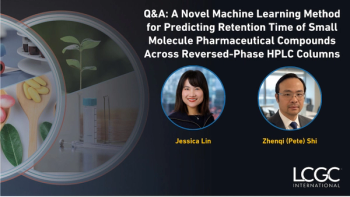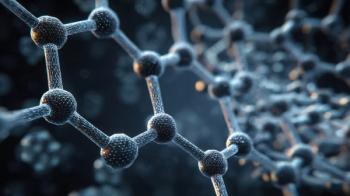
Reaching for the Stars with Mass Spectrometry
LCGC International spoke to Amanda Patrick, associate professor at Mississippi State University, about her research exploring mass spectrometry (MS) applications in ionic liquid analysis.
LCGC International spoke to Amanda Patrick, associate professor at Mississippi State University, about her research exploring mass spectrometry (MS) applications in ionic liquid analysis. Used as lubricants, solvents, catalysts, and spacecraft propellants, ionic liquids are made of bulky organic cations and inorganic or organic anions. Named an “Emerging Investigator” by the Journal of the American Society for Mass Spectrometry, Patrick aims to further our understanding and learn the fundamental properties of these salts.
Your research focus lies in applying mass spectrometry (MS) to the study of ionic liquids–what specifically attracted you to this area of research?
My work has focused on various aspects of mass spectrometry since I began graduate school. However, it was not until my postdoctoral work that I began working with ionic liquids. At that time, the entire focus was on the use of ionic liquids as next-generation “green” spacecraft propellants, which I found really interesting. However, during this time it became clear that there were a lot of gaps in the literature; it also became clear that the “green” monicker had some caveats and that analytical method development needs and environmental contamination concerns were also areas of active research need. So, I think the breadth of the research questions at the crossroads of ionic liquids and mass spectrometry have really kept me engaged in the field since beginning my independent career.
Why are ionic liquids important and what industrial applications are they used in?
Ionic liquids are basically salts that have a very low melting point, which is usually achieved by building cations that are bulky, asymmetric organic species. The organic nature also means that there is a lot of synthetic tunability that is possible, leading to a very large number of potential structures and the possibility for so-called “task-specific” design. As far as industrial applications, they have historically been very interesting for electrochemical devices and for use as solvents. More recently, these task-specific applications have begun to emerge from pharmaceuticals up to spacecraft propellants.
What types of MS have you used to analyze ionic liquids?
Our initial work has focused on mapping gas-phase dissociation pathways using ion traps and quadrupole-time-of-flight (QTOF) instruments, alongside computational chemistry. In our ongoing research, we have begun comparing these gas-phase results with bulk pyrolysis products characterized using gas chromatography (GC)–MS. We are also conducting research using a few different source configurations that will hopefully be coming out soon.
You have published a paper on theoretical and experimental insights into the dissociation of hydroxyethylhydrazinium nitrate clusters formed via electrospray (1). What were the objectives of this research and what were the main conclusions?
Hydroxyethylhydrazinium nitrate, or HEHN, was designed for use as a chemical propellant for spacecraft. It would be useful if it could also double as an electrospray propellant, so we were extending previous work (2) that had characterized the electrospray products to investigate the stability and dissociation pathways of some of the clusters and adducts that were found to be formed. The major conclusion here was that dissociation of these protic clusters seems to follow acid/base neutralization-based dissociation paths, rather than ion pair loss as is typically seen for aprotic clusters. In other words, we see loss of nitric acid or hydroxyethylhydrazine. We then explored this further in a follow-up project using alkylated ammonium cations to better explore this acid/base cluster chemistry. Understanding these things is important to modeling and predicting electrospray performance in the context of electrospray-based propulsion systems.
You recently explored the multi-stage mass spectrometry of common ionic liquid cations and some polyfluorinated ions (3). What was the rationale behind this research? What were your main findings?
There were two motivations for this work and for a companion work on the collision-induced dissociation mass spectrometry (CID-MS) dissociation patterns of imidazolium-based ionic liquid cations that my group conducted (4). First, the isolated cation is the endpoint of the cluster dissociation described previously, so the next step toward understanding the fate of these clusters is to see how the cation dissociates. The second motivation is that a better understanding of the CID-MS behavior as a function of cation scaffold and substituent should help us develop analytical methods for the detection and characterization of ionic liquid species and their degradation products on mass spectrometry platforms. Such analytical method development has many potential areas of relevance, from characterizing novel syntheses to screening for environmental contamination. We have also begun comparing gas-phase dissociation of the isolated cation—such as was explored in this work—to ongoing studies of bulk decomposition of ionic liquids and we hope to have some of those results published soon.
What are the challenges involved in this kind of research?
On a practical side, ionic liquids are involatile and are salts, so there can be some contamination or instrument “cleanliness” concerns depending on concentrations and conditions. Likewise, there can be some structure-dependent solubility differences that have to be considered. On a more general note, one of the major challenges of ionic liquids as analytes is the sheer number of structural possibilities and degree of tunability through alteration of scaffolds, substituents, and anions. There’s still a lot to learn—from fundamentals to method development—and that keeps the work motivating and exciting.
Do you have any advice for early career researchers who are using mass spectrometry for the first time?
I believe it is important to learn the principles and the hardware of the instrument. In other words, avoid treating analytical instrumentation as the so-called “black box”. I think this helps the data make more sense, helps you troubleshoot potential issues, and it also gives you the basis upon which to eventually be a bit more creative or innovative.
Congratulations on being named as an “Emerging Investigator” by the Journal of the American Society for Mass Spectrometry. What does this recognition mean to you?
Thank you! I really appreciate the recognition and the chance to highlight some of the work of my students in the Special Issue of JASMS. It is a nice acknowledgement of the work we have done thus far. I am continually grateful for the phenomenal ASMS and mass spectrometry community and the impact that has had on my career.
References
(1) Patrick, A. L.; Vogelhuber, K. M.; Prince, B. D.; Annesley, C. J. Theoretical and Experimental Insights into the Dissociation of 2‑Hydroxyethylhydrazinium Nitrate Clusters Formed via Electrospray. J. Phys. Chem. A 2018, 122, 1960−1966. DOI: 10.1021/acs.jpca.7b12072
(2) Prince, B. D.; ritz, B. A.; Chiu, Y.-H. In: Ionic Liquids: Science and Applications, ACS Symposium Series, 2012; pp. 27–49.
(3) Abdulraheem, T.; Wallinger, J. G.; Carlo, M. J.; Patrick, A. L. Survey of the Multi-stage Mass Spectrometry of Common Ionic Liquid Cations and Some Polyfluorinated Ions. Int. J. Mass Spectrom.2024, 499, 117218. DOI: 10.1016/j.ijms.2024.117218
(4) De Silva, M.; Brown, A. C.; Patrick, A. L. Thermal- and Collision-induced Dissociation Studies of Functionalized Imidazolium-based Ionic Liquid Cations. J. Mass Spectrom. 2020, 55 (9), e4518. DOI: 10.1002/jms.4518
Amanda Patrick obtained her BS in chemistry, with a minor in anthropology, from North Carolina State University in 2011 and earned her PhD in chemistry from the University of Florida in 2016, under the direction of Dr. Nick Polfer. She then spent two years as a postdoctoral research associate at the Air Force Research Laboratory, Space Vehicles Directorate. In Fall 2018, Amanda began her independent research career at Mississippi State University, being promoted to the rank of associate professor in Fall 2024. In 2022, she was named a Cottrell Scholar, underscoring her commitment not only to research but also to mentoring and teaching.
Newsletter
Join the global community of analytical scientists who trust LCGC for insights on the latest techniques, trends, and expert solutions in chromatography.




